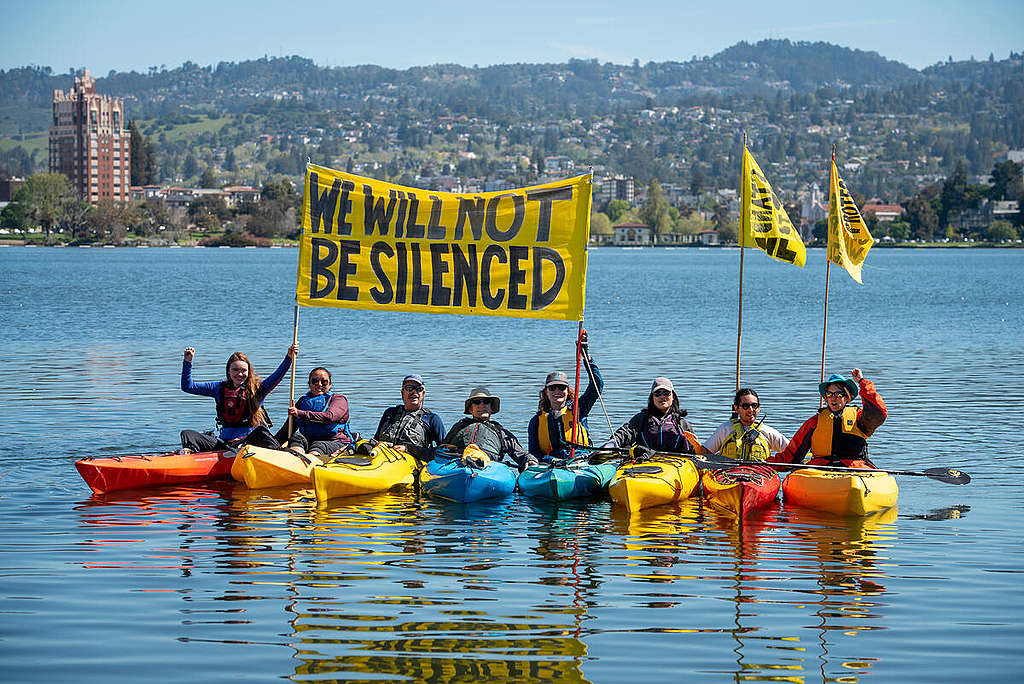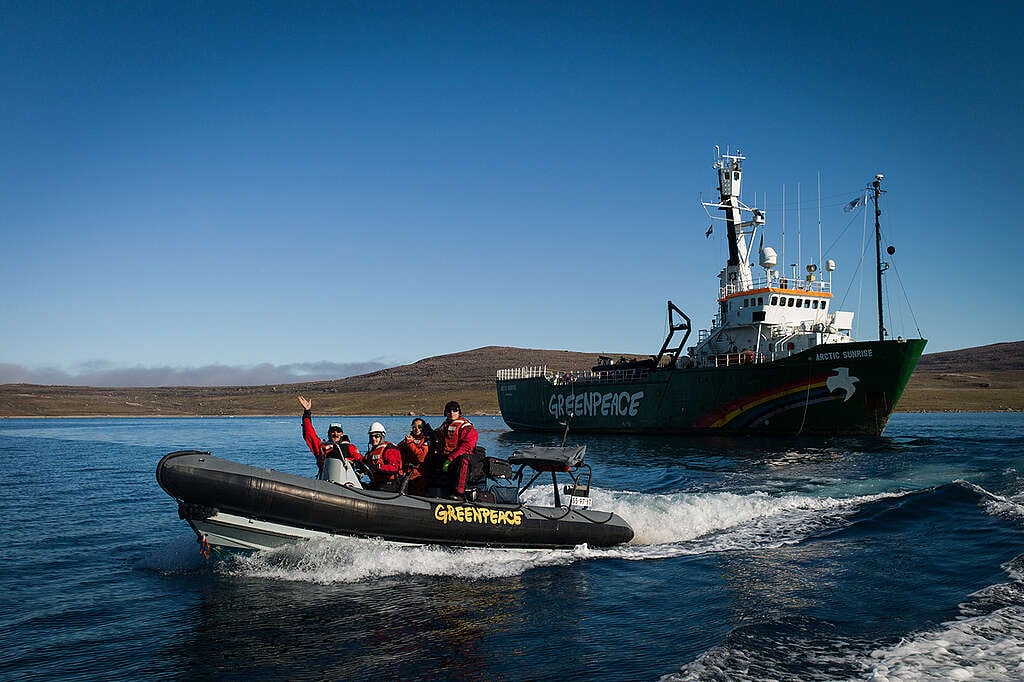This was adapted from a post originally published by Greenpeace USA.
Big Oil companies like Energy Transfer and corporate polluters all around the world have a new weapon they are using to silence anyone advocating for a just, green, and peaceful future: SLAPP lawsuits. In recent years, these Strategic Lawsuits Against Public Participation (SLAPP) have been wielded by corporations attempting to suppress free speech and limit people power.
Greenpeace USA and Greenpeace International are scheduled to go to trial in North Dakota, USA. We are being sued by Energy Transfer - a US-based fossil fuel company that is responsible for the Dakota Access Pipeline - for nearly US $300 million related to the Indigenous-led 2016 protests at Standing Rock. Not only does this SLAPP attempt to rewrite the history of this movement led by the Standing Rock Sioux, but a loss at trial could prove destructive to Greenpeace in the US and have widespread impacts for the climate justice movement all around the world.
Energy Transfer's SLAPP against Greenpeace is a crucial test of this dangerous legal tactic that, if successful, could be widely applied against peaceful protesters, and indeed, anyone who speaks out or criticises a deep-pocketed corporation. Let's take a deeper look at the backstory of this lawsuit, the threat posed by SLAPPs, and why this case matters for all of us.
The real story of Standing Rock
In 2016, the entire world was riveted by the resistance led by the Standing Rock Sioux Tribe against the Dakota Access Pipeline (DAPL). Tens of thousands of people, including members of more than 300 tribal nations, travelled to protect the water and to show solidarity with Standing Rock. In October 2016, United Nations representatives visited Standing Rock and voiced concerns about Indigenous sovereignty.
The Dakota Access Pipeline (DAPL), proposed by Energy Transfer and its partners in 2014, would have carried crude oil from North Dakota's Bakken oil field to Illinois, and then down to the US Gulf Coast. DAPL was part of the fracking boom that began in the region in 2008 that also spurred the construction of oil export terminals and other infrastructure, all of which lock us into more fossil fuel dependence, harm nearby communities, and undermine the slow progress we are making on meeting the Paris Agreement goals.
From the very start, members of the Standing Rock Sioux Tribe, along with other Sioux Nations, opposed the pipeline. Tribal chairman Dave Archambault put the pipeline in historical perspective: "Whether it's gold from the Black Hills or hydropower from the Missouri or oil pipelines that threaten our ancestral inheritance, the tribes have always paid the price for America's prosperity."
Starting in April 2016, tribal members set up prayer encampments near the proposed water crossing, and young Water Protectors organized a 500-mile relay run to deliver a letter to the US Army Corps of Engineers. In July 2016, Standing Rock filed a lawsuit against the US Army Corps to block approval of the pipeline. As the construction of the "Black Snake" drew closer and closer to the river in summer and fall of 2016, the growing anti-pipeline protests captured national and then global attention.
Then in November 2016, Donald Trump was elected US president. While the preceding Barack Obama administration had rejected Energy Transfer's land access request for the pipeline in December 2016, one of Trump's first acts was to approve the pipeline. Energy Transfer CEO Kelcy Warren had recently donated US $250,000 to his Inauguration, and later gave US $10 million to Trump's 2020 re-election effort. Construction was completed and the pipeline went into operation in June 2017.
Although oil was flowing, the Standing Rock Sioux Tribe was not done fighting. Their lawsuit continued on, and in 2020 a US federal judge ordered the Army Corps to conduct a full Environmental Impact Statement on the pipeline crossing. However, an order to shut down the pipeline was not upheld. Today, the Standing Rock Sioux Tribe is still demanding that "the Corps shut the pipeline down and conduct a proper environmental review, not one prepared by the fossil fuel industry."

Energy Transfer wants revenge, not justice
The fight against DAPL is still ongoing, but the 2016 and 2017 Standing Rock protests were powerful displays of resistance to corporate power that clearly rattled Big Oil. Since 2016, broad fossil fuel anti-protest laws have been enacted in 18 US states. All around the world, close relationships between fossil fuel entities and government officials have succeeded in many efforts that shrink civic space and heighten the consequences for engaging in peaceful protest.
In the case of Energy Transfer, they turned to the courts.
Energy Tranfer's initial 2017 lawsuit - a truly wild piece of creative writing that, among other things, claimed that Greenpeace and not the Standing Rock Sioux Tribe or Indigenous water protectors was the organizer behind the protests - was dismissed by a US federal judge in 2019. But Energy Transfer refiled the suit in North Dakota state court with many of the same bad-faith arguments.
In a pair of 2017 media interviews, Energy Transfer CEO Kelcy Warren talked about the rationale for the first lawsuit. In one interview Warren stated that he was "absolutely" trying to "cease funding" for Greenpeace, and in another claimed that his "primary objective" was not recovering monetary damages but rather to "send a message, you can't do this, this is unlawful and it's not going to be tolerated in the United States."
What's more, this lawsuit may have been part of a coordinated effort to go after Greenpeace in particular. The same law firm that filed the ET suit had the year before filed a similar SLAPP suit against Greenpeace on behalf of Resolute Forest Products. Greenpeace finally won that lawsuit outright in 2023; the case was resolved in 2024 after nearly a decade of litigation. The firm in question - Kasowitz Benson Torres, founded by one of Trump's personal attorneys - told Bloomberg that they were "in touch with other companies" that were thinking of suing Greenpeace.
SLAPPs vs. People Power
Like all SLAPPs, Energy Transer's current, meritless US $300 million lawsuit against Greenpeace is an attack on two key elements of public advocacy: free speech and peaceful protest. A bad ruling in this case could have dire repercussions for anyone who attends a protest or who dares to speak up and criticise a powerful, deep-pocketed corporation.

The report "SLAPPed but not silenced: Defending human rights in the face of legal risks" published in 2021 by the Business & Human Rights Resource Center, documented 355 legal cases around the world bearing the hallmarks of SLAPPs since 2015. These bullying lawsuits were brought or initiated by business actors against organisations or individuals and groups related to their defence of human rights or the environment.
For more than 50 years, Greenpeace has taken action in defence of people and the planet. To ensure we can continue this work, let Energy Transfer know that #ImWithGreenpeace.
Greenpeace needs your support against Big Oil's attempt to silence us!







